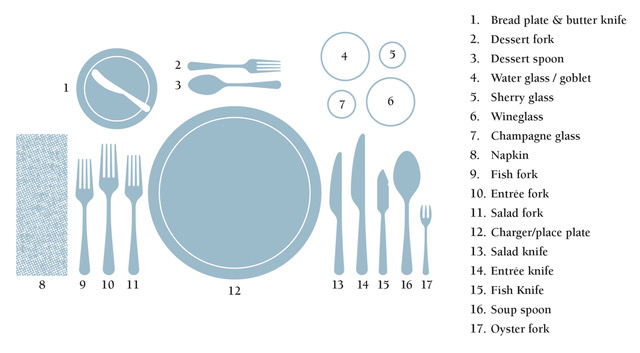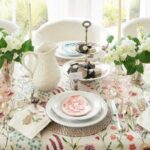A Guide to Elegance and Etiquette
Table of Contents
How to set up dinner table for a formal dinner
Setting a formal table for dinner is more than just arranging utensils and dishes—it’s a ritual that reflects elegance, sophistication, and respect for your guests.
Whether you’re hosting a lavish dinner party or a formal family gathering, knowing how to setting a formal table is essential. Having this knowledge will help you at any formal dinner party you attend as well!
In this comprehensive guide, we’ll delve into the intricacies of formal dinner settings, highlighting the golden rule of utensil placement and addressing common mistakes that can detract from the overall ambiance. Let’s embark on a journey to master the art of setting a formal dinner table.
Golden Rule
In the world of formal dining etiquette, the golden rule reigns supreme: utensils are placed in order of use, from the outside in.
This fundamental principle ensures a seamless dining experience for your guests, allowing them to navigate through the meal with ease. Imagine each utensil as a chapter in a culinary story, progressing logically from appetizers to main course and dessert. By adhering to this rule, you demonstrate your commitment to hospitality and refinement.
Common Mistakes
Despite being a simple task, setting a formal table can be fraught with pitfalls. Let’s explore some of the most common mistakes that can detract from the overall elegance of your dining experience:
- Utensils Not Placed Properly: Misaligned forks, misplaced knives, and haphazardly arranged spoons can disrupt the visual harmony of your table setting. Use our guide (below) to help you with each course; Dinner, Salad, Fish, Main Course and Dessert. Take care to arrange each utensil with precision, ensuring they are evenly spaced and aligned.
- Fragrant Flowers and Candles: While floral arrangements and candles can enhance the ambiance of your table, choose them wisely. Avoid highly fragrant flowers that may overpower the aroma of your meal, and opt for unscented candles.
- Incorrect Size Tablecloth: Using the proper sized tablecloth is the essential canvas to your table. Proper size, ironed, clean and draped to the floor if necessary. A tablecloth that is too short or too long can detract from the overall aesthetic of your table setting. Use a square tablecloth on a square table, oblong on an oblong and round on a round table. To give your table a layering effect, place a small square tablecloth in the center of a round table or a subtle colored runner on an oblong or square table.
- Distracting Centerpiece: While a striking centerpiece can serve as the focal point of your table, exercise restraint to avoid overwhelming your guests. Opt for low-profile arrangements that allow for easy conversation and unobstructed views across the table.
- Overcrowding with Too Many Dishes: While variety is the spice of life, overcrowding your table with an excess of dishes can create confusion and clutter. You don’t want to overwhelm your guest. Serve proper tableware when changing courses. For example, only have a salad plate on the table when serving salad. After everyone is finished, add the dinner plate or a fish plate, main course and dessert plate when appropriate.
- Lack of Table Protection: Protect your table from heat, spills, and scratches with the appropriate tableware, such as placemats, coasters, and trivets. Not only do these accessories safeguard your table’s surface, but they also add an extra layer of elegance to your setting.
Basic Table Setting
Photo Courtesy of Karen Sewell
Step-by-Step to Setting A Formal Table
- Start with a clean, well-ironed tablecloth that drapes evenly over the table. A neutral color is best here. Add color with faux flowers or napkins.
- Place a charger or service plate at each setting, serving as a decorative base for the dinnerware.
- Arrange the dinner plate in the center of each charger, ensuring it is aligned with the table’s edge.
- Position the forks to the left of the plate, with the salad fork placed on the outermost side and the dinner fork closest to the plate.
- Place the knife to the right of the plate, with the blade facing inward.
- Position the spoons to the right of the knife, with the soup spoon placed on the outermost side and the dessert spoon closest to the plate.
- Place the water glass above the knife, slightly to the right.
- Position the white wine glass to the right of the water glass, followed by the red wine glass.
- Finally, place the bread plate above the forks, with the butter knife resting diagonally across it.
Glass and Bread Placement
The placement of glassware and bread plate is an essential aspect of formal table setting, adding both aesthetic appeal and functionality to your arrangement:
- Water Glass Placement: The water glass is traditionally placed directly above the knife, slightly to the right. Its central position ensures easy access for guests throughout the meal.
- White Wine and Red Wine Glass Placement: The wine glasses are positioned to the right of the water glass, with the white wine glass placed slightly higher than the red wine glass. This arrangement allows for seamless progression from aperitif to main course. See more on wine glasses here.
- Bread Plate Placement: The bread plate is positioned above the forks, slightly to the left of the dinner plate. Its proximity to the main setting ensures easy access for guests to enjoy bread or rolls throughout the meal.

Photo Courtesy of Emily Post Etiquette. See more from Emily Post here.
Conclusion
Mastering the art of setting a formal table for dinner requires attention to detail, precision, and a deep appreciation for etiquette and aesthetics.
By adhering to the golden rule of utensil placement and avoiding common mistakes, you can create an ambiance of elegance and refinement that enhances the dining experience for you and your guests.
Whether you’re hosting a grand soirée or an intimate gathering, let your table setting reflect the warmth of your hospitality and the grace of your taste. Cheers to the art of dining in style!






